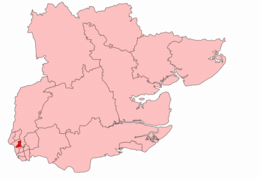Quick facts for kids {{{Name}}}
[[{{{Type}}} constituency]] |
[[Image:{{{Map1}}}Constituency.svg|120px|]]
[[Image:England{{{Map2}}}.svg|120px|]] |
| {{{Name}}} shown within [[{{{Entity}}}]], and {{{Entity}}} shown within England |
| Created: |
{{{Year}}} |
| MP: |
{{{MP}}} |
| Party: |
{{{Party}}} |
| Type: |
House of Commons |
| County: |
[[{{{County}}}]] |
| EP constituency: |
[[{{{EP}}} (European Parliament constituency)|{{{EP}}}]] |
Leyton East was a parliamentary constituency in the Municipal Borough of Leyton, then part of Essex but now in Greater London.
It returned one Member of Parliament (MP) to the House of Commons of the Parliament of the United Kingdom, elected by the first past the post system.
Boundaries

Leyton East in Essex 1918-1950
The Urban District of Leyton wards of Cann Hall, Grove Green, Harrow Green, Leytonstone, and Wanstead Slip.
History
The constituency was created for the 1918 general election, and abolished for the 1950 general election.
Members of Parliament
Elections
Election in the 1910s
Elections in the 1920s
| General election 1929: Leyton East |
| Party |
Candidate |
Votes |
% |
±% |
|
Labour |
Fenner Brockway |
11,111 |
42.9 |
+3.2 |
|
Unionist |
Ernest Edward Alexander |
8,691 |
33.6 |
−12.8 |
|
Liberal |
Frank Wynne Davies |
6,096 |
23.5 |
+9.6 |
| Majority |
2,420 |
9.3 |
N/A |
| Turnout |
25,898 |
72.6 |
−5.0 |
| Registered electors |
35,680 |
|
|
|
Labour gain from Unionist |
Swing |
+8.0 |
|
Elections in the 1930s
| General election 1931: Leyton East |
| Party |
Candidate |
Votes |
% |
±% |
|
Conservative |
Frederick Mills |
17,285 |
62.4 |
+28.8 |
|
Ind. Labour Party |
Fenner Brockway |
10,433 |
37.6 |
New |
| Majority |
6,852 |
24.8 |
N/A |
| Turnout |
27,718 |
75.7 |
+3.1 |
|
Conservative gain from Labour |
Swing |
|
|
| General election 1935: Leyton East |
| Party |
Candidate |
Votes |
% |
±% |
|
Conservative |
Frederick Mills |
10,836 |
46.1 |
-16.3 |
|
Labour |
Albert Bechervaise |
10,507 |
44.7 |
New |
|
Liberal |
Edwin Malindine |
2,161 |
9.2 |
New |
| Majority |
329 |
1.4 |
-23.4 |
| Turnout |
23,504 |
67.1 |
-8.6 |
|
Conservative hold |
Swing |
|
|
Elections in the 1940s
| General election 1945: Leyton East |
| Party |
Candidate |
Votes |
% |
±% |
|
Labour |
Albert Bechervaise |
13,048 |
65.7 |
+21.0 |
|
Conservative |
Bernard Braine |
6,802 |
34.3 |
-11.8 |
| Majority |
6,246 |
31.4 |
N/A |
| Turnout |
19,850 |
68.2 |
+1.1 |
|
Labour gain from Conservative |
Swing |
|
|


